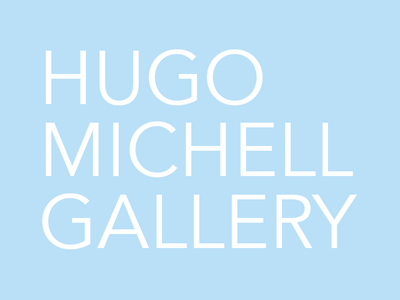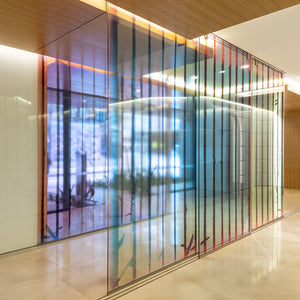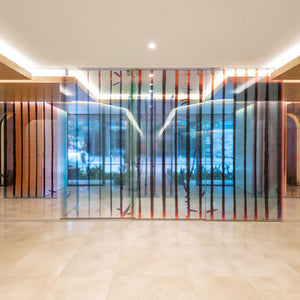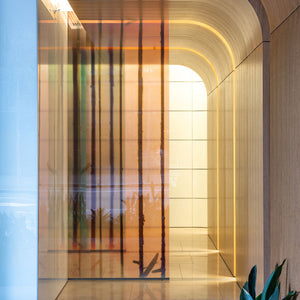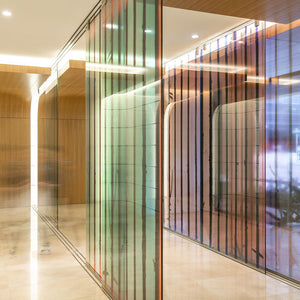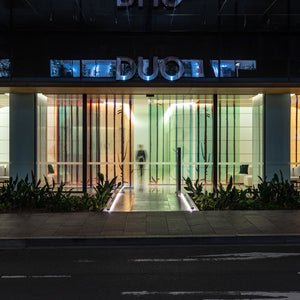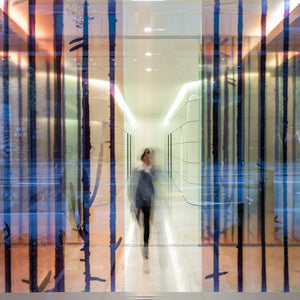Artist Statement
The panels that comprise Fusuma derive from a single cameraless exposure of a 10 x 8 inch negative. This exposure was made while I was resident in London. It was there that I was briefed about the DUO project and its accompanying lanai concept: a concept in which the inside and outside converge. From the outset, I thought of the commissioned artwork as the result of an exchange between locations, between the external and internal, but also between Foster + Partners, a London-based architecture firm, and Frasers Property in Sydney, and even extending the idea to myself, someone who resides between the two cities.
As I was unable to make a site visit in Sydney, as a beginning point I visited the Foster + Partners offices in London. On this excursion, I was struck by the syncopated visual effect the building created with the many grids found on its exterior, contrasted with its location by the fluid River Thames. This evoked the central idea of the lanai concept for me, as an interplay between built and natural environments. As a Sydney-sider myself, this also embodied the relationship I feel to the natural environment, even while I inhabit an urban setting. It is a phenomenon of the Sydney experience that you are only ever moments away from walking through the bush and diving into the sea. As someone who takes advantage of this proximity, I am always awed, while swimming in the harbour, by the abundance of crown bushland and that I can see the CBD just beyond. As the residents enter DUO and interact with Fusuma, it is my desire that the artwork will evoke a similar sensorial experience.
The artwork, while seemingly simple in form, belies a complex process of production. The negative from which it was derived was exposed for over a month in my London studio. As occurs in a lot of my cameraless work, certain marks were made on the surface of the negative during this extended exposure time. These marks were translated into a photographic image featuring a series of vertical striations, recalling the forms of tree trunks or bamboo or perhaps Monet’s paintings of poplar trees. To make the commissioned work, this single image has been divided evenly over two sets of three glass panels. The image has been reversed and the colour has been inverted across each set of panels. Having been transposed onto these sheets of glass, the photograph becomes a public object, a piece of architecture, something one looks at as well as through. The use of glass continues the theme of the work, being both solid and liquid, both there and not there. The changes in medium and colour, and the mirroring of the image, adhere to the logic of photographic processes and reproduction.
As the work’s title implies, I imagined the panels as sliding screens in the Japanese tradition, screens that divide the foyer space but which also remain translucent and evanescent rather than a visual barrier. Light passing through the glass panels falls on those who look at them, casting the interior with a glow of warmth and offering an interactive and immersive experience to the building’s occupants. That light also projects the vertical striations on the panels onto the floor beyond them, as if each panel was a slide or a negative in an enlarger. The work therefore constantly changes, depending on the lighting conditions and the movement of the observer. Visually, each set of panels flows through the other, like the spring allows for and precedes the summer.
Indeed, Fusuma’s temporal and spatial shifts become especially apparent as the building’s occupants move across the foyer and interact with the work. This is a public art work that invites its audience to take a creative role in its presentation. The panels can be moved across the expanse of the foyer along tracks, recalling the syncopated staccato seen when moving through trees (an echo of my initial observations at the Foster + Partners offices in London). Each panel can be viewed as stand-alone work, together as the full image, or layered in various configurations. This feature harnesses Fusuma’s translucent quality while also allowing the inhabitants of DUO to interact with the artwork, where they will mix with colour and define the form of their own space. This potential motion adds the unpredictable contingency of life to a space designed as a transit between inside and outside, the domestic and the urban, light and solid.
